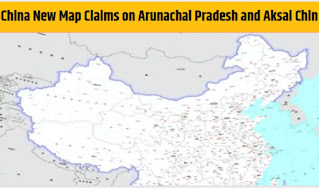China's 2023 Map Release Sparks Political Controversy in India
China's New Map of 2023: China's unveiling of the "standard map" for 2023 on August 28th has caused a significant political uproar, particularly drawing strong reactions from Indian political leaders.
Territorial Claims and Inclusions: The map asserts China's sovereignty over contentious regions. It designates Arunachal Pradesh, which China refers to as South Tibet, and the Aksai Chin region, taken by China during the 1962 war, as integral parts of its territory. Remarkably, the map also encompasses Taiwan and the disputed South China Sea within its borders.Indian Opposition and Reaction: China's map release prompted an immediate and stern response from India. The Indian External Affairs Ministry expressed strong dissent against China's actions. A formal diplomatic protest was lodged, firmly rejecting China's territorial claims. The ministry stressed that these actions only serve to further complicate the already complex boundary dispute.
External Affairs Minister's Statement: External Affairs Minister S Jaishankar responded to China's move by highlighting its history of staking claims over disputed territories. In an interview with NDTV, Jaishankar dismissed China's "absurd claims," emphasizing that publishing a map holds minimal significance.
High-Level Diplomacy and Recent Meeting: Recent interactions between Indian Prime Minister Narendra Modi and Chinese President Xi Jinping at the BRICS Summit in South Africa underscore ongoing efforts to address tensions. The discussions focused on concerns about unresolved issues along the Line of Actual Control (LAC) in the Western Sector of the India-China border.
Efforts Toward Resolution: Prime Minister Modi emphasized the necessity of peace along the border areas and respecting the LAC for normalizing India-China relations. Both leaders agreed to direct officials to intensify efforts toward swift disengagement and de-escalation.
Recurrence of Tactics: China's recent move echoes previous instances of renaming Indian locations, generating political disputes. Similar actions were observed in April, 2017, and 2021. On these occasions, India strongly protested against China's expansionist ambitions.
In the backdrop of simmering geopolitical tensions, China's strategic maneuvers in disputed regions trigger rapid responses and renew the importance of diplomatic dialogue for resolution.






Post a Comment